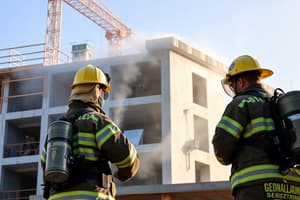Podcast
Questions and Answers
What does white smoke indicate during the initial stages of heating?
What does white smoke indicate during the initial stages of heating?
- The fire is moving rapidly.
- The material is undergoing carbonization.
- The presence of moisture in the material. (correct)
- The material is completely dry.
What kind of smoke indicates a loss of strength in structural materials?
What kind of smoke indicates a loss of strength in structural materials?
- White smoke.
- Black smoke.
- Grey smoke.
- Tan or brown smoke. (correct)
What characterizes black smoke in a fire scenario?
What characterizes black smoke in a fire scenario?
- A sign of a fully extinguished fire.
- High temperatures exceeding 1000° and high volume. (correct)
- Low volume and slow velocity.
- Presence of unburned wood particles.
In the context of reading smoke, which of the following factors is NOT used for assessing smoke characteristics?
In the context of reading smoke, which of the following factors is NOT used for assessing smoke characteristics?
What behavior is essential when visually assessing smoke for tactical decisions?
What behavior is essential when visually assessing smoke for tactical decisions?
What does low mass content in smoke indicate?
What does low mass content in smoke indicate?
What characterizes turbulent smoke?
What characterizes turbulent smoke?
What occurs when dense smoke is present?
What occurs when dense smoke is present?
How does laminar smoke behave compared to turbulent smoke?
How does laminar smoke behave compared to turbulent smoke?
What leads to flashover being delayed?
What leads to flashover being delayed?
What is one of the consequences of crawling through zero visibility smoke?
What is one of the consequences of crawling through zero visibility smoke?
What can thick black smoke indicate about a fire situation?
What can thick black smoke indicate about a fire situation?
What effect does the size of an opening have on smoke flow?
What effect does the size of an opening have on smoke flow?
What type of smoke indicates a fire is closer to the firefighter?
What type of smoke indicates a fire is closer to the firefighter?
What is pyrolysis in the context of smoke and fire?
What is pyrolysis in the context of smoke and fire?
How does smoke behavior change when a door is opened during firefighting?
How does smoke behavior change when a door is opened during firefighting?
Which of the following is NOT a key attribute of smoke leaving a structure?
Which of the following is NOT a key attribute of smoke leaving a structure?
What causes smoke gases to ignite in a pressurized room?
What causes smoke gases to ignite in a pressurized room?
What could indicate the presence of a concealed or deep seated fire?
What could indicate the presence of a concealed or deep seated fire?
Which factor does NOT affect smoke behavior in a structure?
Which factor does NOT affect smoke behavior in a structure?
What is referred to as a 'sucker punch' in firefighting tactics?
What is referred to as a 'sucker punch' in firefighting tactics?
What happens to smoke gas just above its ignition temperature?
What happens to smoke gas just above its ignition temperature?
What could hinder proper smoke analysis during a fire incident?
What could hinder proper smoke analysis during a fire incident?
Flashcards are hidden until you start studying
Study Notes
Smoke Behavior in Fire Dynamics
- Smoke serves as a vital indicator of fire behavior inside structures, guiding tactical decisions for firefighters.
- Dark, fast-moving smoke suggests proximity to the fire, while slow, lighter smoke indicates distance.
- Uniform smoke velocity and color from multiple openings suggest a concealed fire or deep-seated conditions.
Composition and Properties of Smoke
- Smoke consists of toxic, flammable, and volatile materials, including solids and aerosols (e.g., hydrocarbons like tar/oil).
- Hot smoke can significantly affect fire behavior and is highly flammable, potentially igniting from sparks.
- Pyrolysis refers to the process where materials release gases without flame, leading to potential ignition.
Key Attributes of Smoke
- Volume: Reflects the amount of fuel off-gassing; low mass contents may produce large volumes of smoke with minimal flame.
- Velocity: Indicates the speed of smoke movement; influenced by heat and volume changes, affecting pressurization.
- Turbulent smoke suggests a higher risk of flashover, while laminar flow indicates stability.
- Density: Thicker smoke indicates greater fire spread potential; it also reduces life sustainability due to toxic content.
- Color: Provides insight into material combustion; colors range from white (initial heating) to black (high carbonization).
Critical Smoke Color Indicators
- White Smoke: Indicates initial heating; its velocity can signify distance from the fire.
- Tan/Brown Smoke: Associated with wood materials; indicates a transition from content burning to structural involvement.
- Grey Smoke: Often results from burning plastics or treated materials.
- Black Smoke: Indicates high volume and temperatures, pointing to severe fire conditions and potential impending flashover consequences.
Understanding Fire Dynamics
- An explosive surge can occur if ignition happens in a pressurized room, altering fire behavior.
- The volume switch effect occurs when a door opens, allowing smoke and air to exchange places, impacting fire dynamics.
- Analysis of smoke must consider environmental factors such as wind, thermal balance, and structural elements like sprinkler systems.
Importance of Smoke Recognition
- Direct observation and vocalization of smoke characteristics enhance recognition and decision-making during firefighting.
- Practicing with raw video footage helps develop the critical skills of assessing smoke conditions quickly and accurately.
- Understanding smoke behaviors provides strategic advantages, ensuring firefighters respond effectively to evolving fire scenarios.
Studying That Suits You
Use AI to generate personalized quizzes and flashcards to suit your learning preferences.




